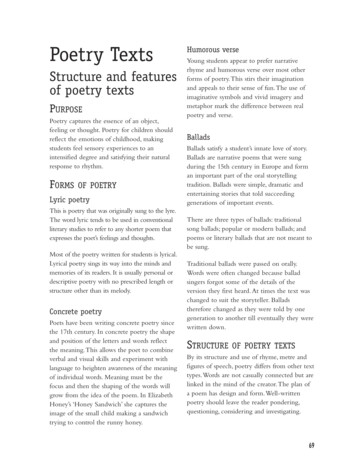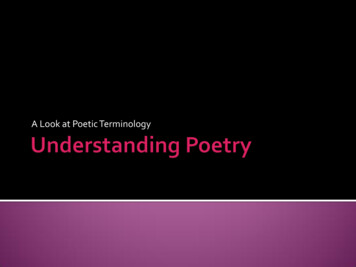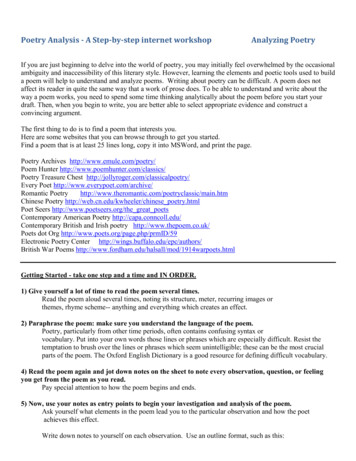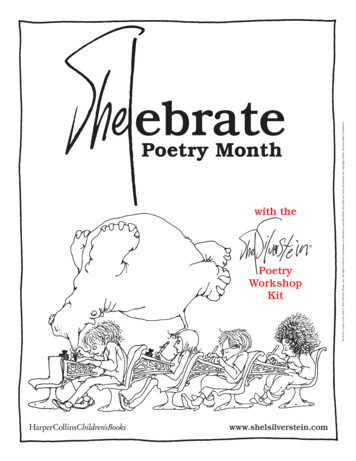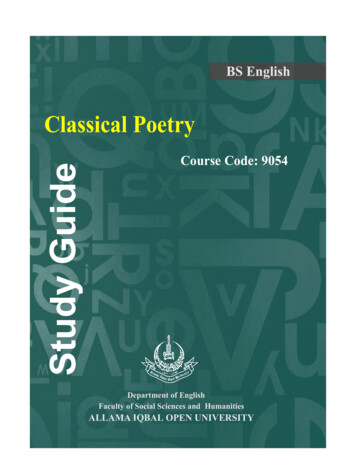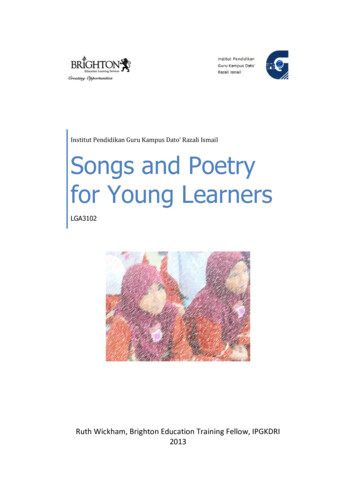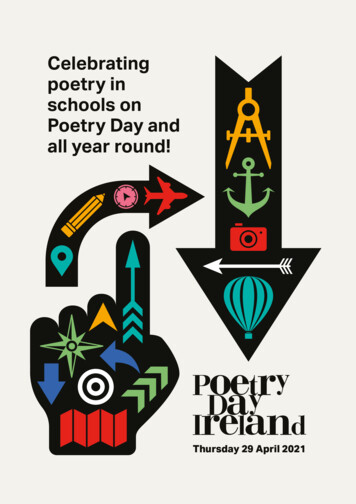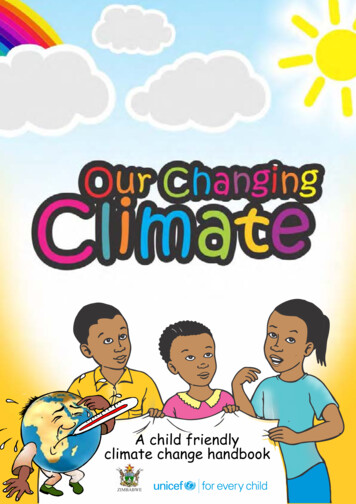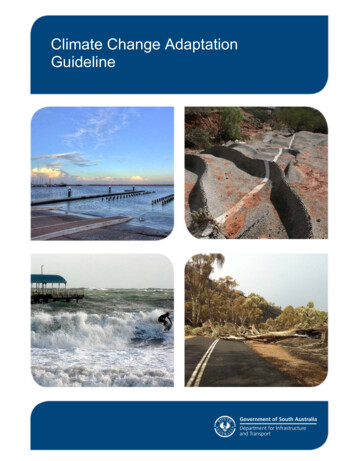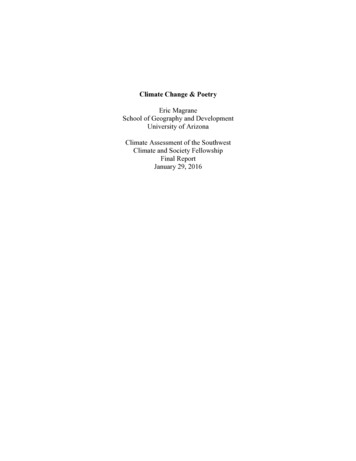
Transcription
Climate Change & PoetryEric MagraneSchool of Geography and DevelopmentUniversity of ArizonaClimate Assessment of the SouthwestClimate and Society FellowshipFinal ReportJanuary 29, 2016
ContentsExecutive Summary 2Introduction .4Project Design and Methodology 5Target Audiences and Stakeholders .7Main Outcomes and Outputs . .8Lessons for Use-Inspired Outreach .8Next Steps . . .10Acknowledgements . . . 10References . .11Appendices:Appendix A: Syllabus 12Appendix B: Overview of Selected Readings Used in Course .13Appendix C: Assignment to Bring a Poem for Discussion . .141
Executive SummaryAs a CLIMAS fellow, I designed and taught a community course on Climate Change &Poetry, one of the first of its kind anywhere. The course took place at the University ofArizona Poetry Center in the fall of 2015, and included six class meetings, each of whichwas two hours. I designed the course around the growing body of contemporary poetrythat engages with climate change, and alternated readings of poetry with readings onclimate change.I drew on both my background as a geographer and as a poet in designing this course. Ibrought both of these approaches to the facilitation of the course, as well, drawing onboth social science and humanities orientations in facilitating and leading theconversations of the texts at hand—be they poems or climate reports or chapters frombooks on the social aspects of climate change.Climate change is both a social and a scientific issue and many frames exist throughwhich we can approach it. There is not one climate change; rather, there are many climatechanges. This refers to both the physical science of climate change—the awareness thatdifferent regions will see different effects of climate change, highlighted in NCA andIPCC reports, for example, and reflected in the missions of RISAs like CLIMAS or inregional assessments such as the Assessment of Climate Change in the Southwest UnitedStates—as well as to the social perception of climate change. A few of the differingnarratives of climate change place it alternately as a ‘wicked problem’ to be faced byinter- or trans- disciplinary approaches, an environmental justice issue, a national andglobal security issue, an apocalyptic threat to life on earth, or an opportunity for socialchange. (For just a few examples of the literature on environmental narratives or“frames,” see Boykoff 2011, Hulme 2009, Lejano et al 2013, Liverman 2009, Manzo2012, and Wilder et al 2015)Art and poetry offer novel ways in which those climate frames or narratives can becommunicated or explored. This is true even if the poem itself is not in a narrativemode—as was often the case in the poems we explored in class. Sometimes a poemreflects common narratives, while at other times a poem may complicate or disrupt thosenarratives.In situating the course theoretically, I approached the poems as boundary objects thatcould contain multiple climate narratives and understandings. Some of the poems welooked at addressed climate change explicitly, while others did so implicitly. Somereflected a strong sense of the environmental justice aspects of climate change; somereflected an attempt to try to find hope; some worked like elegies; some drew on ahumorous or satirical tone.The course was designed to resonate in multiple registers. While primarily designed as anoutreach project, the course also was a means to do research on climate perception andliterary geographies of climate change. In addition, the CLIMAS fellowship made itpossible for me to donate my percentage of the course enrollment fees ( 650) to2
Watershed Management Group, a local environmental nonprofit that works on waterharvesting and green infrastructure. Community participants left the course with anincreased awareness of the science and social impacts of climate change as well as astrong awareness of environmental poetry.Early outputs from the course include multiple academic presentations, including “GoDeep and be Ready: Geographies and Poetries of Climate Change,” which I presented atthe Conference of the Association of Pacific Coast Geographers in fall 2015 in PalmSprings, CA; and “Reading Indigenous Ecopoetics and the Geographies and Poetries ofClimate Change,” which I will present at the 2016 Association of American GeographersAnnual Meeting in San Francisco. Two academic articles are also in preparation.The course has helped to inspire other climate change and poetry interactions. Mostnotably, The University of Arizona Poetry Center is now planning a full reading seriesfor fall 2016 around climate change.At the beginning of the class, one of the questions I asked students in a short survey was“In your own words, what is climate change?”One of the students wrote: “a humanly caused change in the climate’s temperature—overall a rise of several degrees caused primarily by an increasing amount of carbondioxide from the burning of fossil fuels, which has consequences for all life’s creatures.”This reflected a strong knowledge of the physical aspects of climate change, which a fewof the students came to class already having.After the class, that same student answered: “Something that is coming, that is bothcomplicated and simple, that is overwhelmingly moral, that is disastrous yet not withouthope in that it challenges us to be imaginative in its wake.”“To be imaginative in its wake.” I think this insight is very important, is perhaps even oneof the most crucial for those of us working on climate change.3
IntroductionAt the September 2014 UN Climate Summit in New York, Kathy Jetnil-Kijiner, a poetfrom the Marshall Islands, performed a poem dedicated to her young daughter. The poemspeaks of hope for the future in the midst of sea level rise for a homeland—standing justtwo meters above sea level—that is on the frontlines of climate change. It makesreference to climate change refugees and has a strong sense of environmental and socialjustice. An excerpt from the poem reads:no one’s drowning, babyno one’s movingno one’s losingtheir homelandno one’s gonna becomea climate change refugeeor should i sayno one elseUK’s The Guardian recently published a series of twenty poems on climate changecurated by Carol Ann Duffy, the poet laureate of Britian. The winter 2014 issue of ISLE,Interdisciplinary Studies in Literature and Environment, focused its whole issue onglobal warming. Part of one of the poems in that issue, titled “Teaching ClimateChange,” by the poet Stephen Siperstein, reads:My students arrive every Tuesdayand Thursday afternoon, asking questions–“How worried should we be?”Swiftly my voice rolls out, “very”–like a wave breaking over itself,then pulling back.“So what should we do?” they ask–And I try to hear goodness and grace,a little luck, and the sounds of a lake fallingthrough trees at night, and any wordsthat might begin an answer.These are just a few examples of work by contemporary poets that engages with themany aspects of climate change that I looked to in designing a course around climatechange and poetry. I approached the poems in two ways: 1) they helped to communicatethe situations of climate change; 2) they point to other ways of understanding humannature relationships and the role of imagination in moving forward.4
Here, I think of Marshall McLuhan’s idea of art as “a DEW line, a Distant Early Warningsystem that can always be relied on to tell the old culture what is beginning to happen toit” (quoted in Buckland, 2009). David Buckland, founder and director of Cape Farewell,an international artists group focused on the cultural response to climate change, looks tothis concept from McLuhan, and I think it is also useful to approach contemporary poetrydealing with climate change.The geographer Mike Hulme (2009) has suggested that “we need to reveal the creative,psychological, ethical and spiritual work that climate change is doing for us.” This, ofcourse, has been reflected in recent popular books like Naomi Klein’s This ChangesEverything, or in the Pope’s comments on climate change as a moral issue. This issomething that I found in the class, too, that moving from a perspective of hopelessnessto one of agency was something that the students longed for.Project Design and MethodologyDrawing on Latour and Callon, Star and Griesemer (1989) proposed the concept of theboundary object as "an analytic concept of those scientific objects which both inhabitseveral intersecting social worlds and satisfy the informational requirement of each ofthem.” In my thinking on this course, I propose to extend the concept of boundary objectoutside of a scientific field to place the poems as boundary objects. A key aspect ofboundary objects is their “interpretive flexibility” and a poem, by nature, has interpretiveflexibility.While this boundary concept has been taken up mostly in the realm of social studies ofscience, I am working through the use of the term in approaching climate change poems.The concept is often taken up through boundary organizations—particularly aroundconnecting science with decision-making, and is mobilized to think at the organizationallevel (see Star 2010). I suspect that it can be approached as an analytic to think through a)the organizational level of a poem and b) to think through the poem as a boundary objectbetween different conceptions and narratives of climate change and their audience. Aspart of the class, I pre- and post- surveyed the students on their knowledge and relation toclimate change, and we also did writing exercises/prompts throughout—and I will usethat as data to continue to think through this idea of boundary object further.Questions of global environmental change are increasingly understood as socialchallenges as much as scientific challenges. In “The Social at the Heart of GlobalEnvironmental Change,” Hackman et al (2014) write: "The environmental challenges thatconfront society are unprecedented and staggering in their scope, pace and complexity.Unless we reframe and examine them through a social lens, societal responses will be toolittle, too late and potentially blind to negative consequences." As an outreach project,this course was also designed to communicate this idea implicitly through discussion ofthe texts at hand.5
The course included both facilitated discussion of texts, short mini-lectures on climatetopics, as well as short in-class writing exercises based off of our readings. A few ofthose in-class exercises included, for example:o After watching a video clip of Kathy Jetnil-Kijiner’s performance of “dear matafelepeinam” at the 2014 UN Climate Summit, draft a poem to a young person (thiscould be someone specific—a child, grandchild, niece, nephew—or it could besomeone in the future).o After reading W.S. Merwin’s poem “Place,” which beings “On the last day of theworld/I would want to plant a tree,” draft a poem that begins by stealing Merwin’sfirst line. “On the last day of the world ”o After reading the introduction to Naomi Klein’s This Changes Everything andexcerpts from Stephen Collis’s The Commons, let’s write a collaborative poem. Wedrafted these poems in the form of an “exquisite corpse,” a surrealist collaborativewriting exercise, in which each contributor adds a line to a collaborative poem afterbeing able to see only the one line prior.These exercises, as well as serving as a fun means to generate writing for the courseparticipants, also allowed for multiple ways in to discussions of climate narratives.Figure 1: Example of “exquisite corpse” in-class writing exercise from Climate Change & Poetry. Eachcontributor wrote a line only seeing the one prior line, so that the poem would accrue in an organic way.Note this poem reflects rising sea level as well as an interesting connection with political economy (“Sell aplanet, buy a lottery chance.”)6
Target Audiences and StakeholdersThe primary target audience and stakeholders for this course included:o CLIMAS.o The University of Arizona Poetry Center, which hosted the course in their Fall2015 Classes and Workshops Series, and helped to publicize the course.o Watershed Management Group, which received a donation of 650 out of thecourse fees.o The nine students—adults up through retirement age—who enrolled in and took thecourse.In addition, an expanded audience of the project to date also includes:o Those who read about the course through my CLIMAS blog post announcing thecourse, or the Poetry Center’s social media on the course.o Conference-goers who attended my presentation on the course at the 2015Conference of the Association of Pacific Coast Geographers or at the upcomingAssociation of American Geographers 2016 Annual Meeting.Main Outcomes & OutputsThis course was successful in a number of ways. It has helped inspire other connectionsbetween poetry and climate change, including an upcoming series at the Poetry Centerfocused on climate change. In addition, Joan Engel, a student in the course, will present atalk on the “Poetry of Climate Change” at this year’s international forum of the GlobalEcological Integrity Group (GEIC).In a survey on the course collected by the Poetry Center by email after the course wascomplete, seven students responded and all respondents rated the course as excellent (6)or good (1). Example comments included:“Climate change is a heavy topic so it was good to experience a variety of typesof materials—as well as the lively discussions ”“We were given information on climate change and read poetry written on thistopic. There was also time for group discussions and some fun writing exercises,so there was definitely a good balance and the course was structured well. Ienjoyed our discussions. I didn't know very much at all about environmentalpoetry until I took this class. The course provided a great introduction anddefinitely sparked my curiosity, encouraging me to lean more, and to write someof my own poems. I have been enthusiastically talking about this class and manypeople I've spoken to have expressed an interest in taking the class ”7
Outputs related to the course include:o Publicity on the course, including a CLIMAS blog post that was also highlightedon the Poetry Center’s social media, allowed the impact of the course to reach abroader audience (including, for example, over 200 Facebook “likes” in response tothe Poetry Center post).o Two academic articles in preparation.o Multiple conference presentations as noted above.Lessons for Use-Inspired Outreach“Culture is a powerful force in our society. By exploring and scrutinizing our societalvalues, it challenges attitudes and changes what we deem to be ‘normal’. By influencingthe cultural narrative, creativity has played a key role in tackling gender, racial and sexualinequality. Now, it’s time the environment became part of our cultural narrative.”–from UK NGO Julie’s Bicycle Guide to Communicating Sustainability, 2015My work on this project—as well as on other collaborative art and environmentprojects—has reinforced for me the idea that research and outreach projects that draw onart and literature should be designed in mind for their ability to catalyze change and toinspire others. An out-of-the-box climate outreach project such as this can have effectsboth short-term and long-term. Theoretically, this is also related to the concept ofboundary objects, or to iterative processes of connecting science with decision-making.The course as an outreach project can itself be looked at as a boundary object, one whichhas served to further connect climate and culture at the University of Arizona and in thebroader community.Time and relationship-building cannot be understated as an extremely important aspect ofuse-inspired research and outreach. These kinds of projects take time; for me, this projectwas in part possible because of a long-established relationship that I already had in placewith the Poetry Center, including teaching classes such as Ecopoetics in their Classes andWorkshops program in the past. 8
In the first class meeting I asked the participants: “What is climate change?” I noted someof the responses on the board.Figure 2: What is climate change? A few of the group responses to this question posed to class participantson the first class meeting.We then proceeded to weave an ongoing discussion of this question throughout thecourse, building on our original notes.I found that mixing different types of readings on climate change with poems workedvery well. However, I also found, as I had suspected, that in teaching such a course it isimportant to let each form of text do its own work. In other words, my impression wasthat those instances in which I let the poems lead the way—letting the discussion ofclimate narratives happen organically from our interpretation of the poems at hand,seemed to have more impact than when I began with discussion of a climatenarrative/frame, and then read poems through that narrative/frame.Poems, in their close attention to detail—and in their use of concise and distilledlanguage and imagery—can help to translate a presence in the world that brings a climatechange that many in the public still envision as an abstract concept out there in the futureclearly into an embodied and felt present moment. This increased awareness then—hopefully—helps create momentum and support for action at scales from the individualto the global.9
Next StepsOver the next months I will draft two academic articles from this work: one will be apiece that reflects on the course’s methodology and poetry’s use in climatecommunication, drawing on the concept of boundary objects. The other article will be apiece that does a literary geography of some of the specific poems from the course, inparticular work from Indigenous poets. I will present this article at a featured LiteraryGeographies session at the spring 2016 Association of American Geographers annualmeeting.I also look to this class as a baseline for the development of further Climate Change &Poetry or broader Art & Environment courses, ones that could be taught in thecommunity as well as at undergraduate or graduate levels.AcknowledgementsI am grateful to everyone at CLIMAS for their support on this project and to thecontinued inspiring conversations on art and environment that happen through theInstitute of the Environment’s Arts & Environment Network. This project also could nothave happened without the collaboration of the University of Arizona Poetry Center, andin particular Cybele Knowles, Tyler Meier, and Wendy Burk. At the Poetry Center,Hannah Ensor has also been a driving force in bringing climate change further into theprogramming through development of an upcoming reading series connected to climatechange. And, last but not least, I am of course grateful to the inspiring and insightfulstudents who enrolled in this first Climate Change & Poetry course.10
ReferencesBoykoff, M. T. (2011). Who speaks for the climate?: Making sense of media reporting onclimate change. Cambridge University Press.Buckland, D. (2012). Climate is culture. Nature Publishing Group, 2(3), 137–140.Hackman, H., Moser, S., St. Clair, A.L. (2014). The Social at the Heart of GlobalEnvironmental Change, pp 1-6.Hulme, M. (2009). Why we disagree about climate change. Cambridge University Press.Julie’s Bicycle Guide to Communicating Sustainability. ity-2015.pdf (last accessed 28 January 2016).Lejano, R., Ingram, M., & Ingram, H. (2013). The Power of Narrative in EnvironmentalNetworks (American and Comparative Environmental Policy). The MIT Press.Liverman, D. (2009). Conventions of climate change: constructions of danger and thedispossession of the atmosphere. Journal of Historical Geography, 35(2), 279–296.Manzo, K. (2012). Earthworks: The geopolitical visions of climate change cartoons.Political Geography, 31(8), 481–494.Star, S. L. (2010). This is Not a Boundary Object: Reflections on the Origin of a Concept.Science, Technology & Human Values, 35(5), 601–617.Star, S. L., & Griesemer, J. R. (1989). Institutional Ecology, Translations“ and BoundaryObjects: Amateurs and Professionals in Berkeley”s Museum of VertebrateZoology, 1907-39. Social Studies of Science, 19(3), 387–420.Wilder, M., Magrane, E., Miele, M., Prytherch, D., Schein, R., Ingram, M., & Ingram, H.(2015). The Power of Narrative in Environmental Networks. AAG Review ofBooks, 3(2).11
Appendix A: SyllabusClimate Change & PoetryInstructor: Eric MagraneContact: eric@ericmagrane.comSix Mondays, 6:15 to 8:00 pm, University of Arizona Poetry CenterSeptember 28 through November 9, 2015(no class on 10/26)Course descriptionClimate scientist Mike Hulme has written, “we need to reveal the creative, psychological,ethical and spiritual work that climate change is doing for us.” That is precisely whatwe’ll consider in this class. By blending readings of poetry with social and scientificreadings of climate change, we’ll learn more about environmental poetry and aboutclimate change, and we’ll think about how poetry and creativity may have a role inadapting to a warming world. We’ll read poetry that both directly and indirectlyaddresses climate change, including work by Patricia Smith, Brenda Hillman, StephenCollis, Kathy Jetnil-Kijiner, and many others.Narratives of climate change place it alternately as an environmental justice issue, anational and global security issue, an apocalyptic threat to life on earth, an opportunityfor social change, and more. In this course, we’ll explore how poets are increasinglytaking up the issue of climate change in their work, and consider how poems reflect orcomplicate some of these climate narratives. We will primarily be reading and discussingpoetry in conjunction with climate reports and texts, but we will also incorporate somewriting exercises throughout, generating our own work. The course is open to students ofall skill and experience levels.ReadingsReadings will consist of both poems and readings on climate change. Please do read eachweek’s readings before class. Packets of readings for the following week will be handedout each week. Please bring all packets each week, as we may refer to poems in earlierpackets. If you have to miss a class, I will leave the packet for you at the Poetry Center.12
Appendix B: Overview of Selected Readings Used in CourseReadings for class 1 & 21. Mike Hulme, Preface to Why We Disagree About Climate Change (Cambridge,2009)2. Selected poems from ISLE’s issue on Global Warming (Volume 21, Issue 1,Winter 2014)3. Selected poems from So Little Time: Words and Images for a World in ClimateCrisis (Green Writers Press, 2014)4. Selected poems from Streaming by Allison Adelle Hedge Coke (Coffee HousePress, 2014)5. “dear matafele peinam” by Kathy Jetnil-Kijiner6. “A typology of climate change frames” from Manzo, K. Earthworks: Thegeopolitical visions of climate change cartoons. (Political Geography, 2012)7. U.S National Climate Assessment Overview (brochure)8. Assessment of Climate Change in the Southwest United States (“Key Findings”brochure)Readings for class 3o Selected poems from Blood Dazzler by Patricia Smith (Coffee House Press, 2008)o Selected poems from Meaning to Go to the Origin in Some Way by Linda Russo(Shearsman, 2014)o Selected poems from Through the Second Skin by Derek Sheffield (Orchises,2013)o Selected poems from Hyperboreal by Joan Naviyuk Kane (University ofPittsburgh Press, 2013)o Selected poems from undercurrent by Rita Wong (Nightwood Editions, 2015)o Selection from Flood Song by Sherwin Bitsui (Copper Canyon, 2009)o Selection from To See the Earth Before the End of the World by Ed Roberson(Wesleyan, 2010)Readings for class 4o Introduction from This Changes Everything by Naomi Klein (Simon & Schuster,2014)o Selected poems from The Commons by Stephen Collis (Talonbooks, 2014) andexcerpt from “A Working Manifesto for the Biotariat” (from Spiral Orb nine)o Selected poems from Seasonal Works With Letters on Fire by Brenda Hillman(Wesleyan, 2013)o Selected poems from catalog of unabashed gratitude by Ross Gay (University ofPittsburgh Press, 2015)Readings for class 5 and 6o Selected perceptual challenges from Big Energy Poets of the Anthropocene: WhenEcopoets Think Climate Change edited by Heidi Lynn Staples and Amy King(forthcoming BlazeVOX)o Ten copies of a poem of your choice (see suggested links/resources)13
Appendix C: Assignment to Bring a Poem for DiscussionPlease bring ten copies of a poem of your choice that somehow interacts with ourdiscussion of climate change and poetry. You are welcome to choose a poem from anysource. I’d suggest looking at contemporary and recent poetry, and some sources youmight look at are included below. (This is by no means an exhaustive list, but issomething to get you started.)A Few Websites:o The Guardian Keep it in the Ground: a poem a day series is “a series of 20 originalpoems by various authors on the theme of climate change curated by the UK's poetlaureate Carol Ann ies/keep-it-in-the-ground-a-poem-adayo Poets for Living Waters “is a poetry forum begun in 2010 as a response to the GulfOil Disaster of April 20, 2010, one of the most profound man-made ecologicalcatastrophes in history. The initial project included hundreds of poetry and poeticspublications, and a series of international reading events.”https://poetsgulfcoast.wordpress.com/o Cape Farewell: “Switch: Youth Poetics has been developed by Cape Farewell inpartnership with The Poetry Society. Now in it's second year, Switch 2013/14featured poet Helen Mort (nominated for the prestigious T.S. Eliot Award), andwas for writers up to 25 years-old. It took place online and in secondary schoolsbased in London and Sheffield, from December 2013 to March -and-the-poetry-society.htmlI will also leave a few books on reserve at the Poetry Center. These will be available onthe reserve shelf in the librarian’s office during Poetry Center regular hours.14
Arizona Poetry Center in the fall of 2015, and included six class meetings, each of which was two hours. I designed the course around the growing body of contemporary poetry . books on the social aspects of climate change. Climate change is both a social and a scientific issue and many frames exist through which we can approach it. There is .
